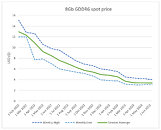T0@st
News Editor
- Joined
- Mar 7, 2023
- Messages
- 2,077 (3.16/day)
- Location
- South East, UK
The price of GDDR6 memory has continued to fall sharply - over recent financial quarters - due to an apparent decrease in demand for graphics cards. Supply shortages are also a thing of the past—industry experts think that manufacturers have been having an easier time acquiring components since late 2021, but that also means that the likes of NVIDIA and AMD have been paying less for VRAM packages. Graphics card enthusiasts will be questioning why these savings have not been passed on swiftly to the customer, as technology news outlets (this week) have been picking up on interesting data—it demonstrates that spot prices of GDDR6 have decreased to less than a quarter of their value from a year and a half ago. 3DCenter.org has presented a case example of 8 GB GDDR6 now costing $27 via the spot market (through DRAMeXchange's tracking system), although manufacturers will be paying less than that due to direct contract agreements with their favored memory chip maker/supplier.
A 3DCenter.org staffer had difficulty sourcing the price of 16 Gb GDDR6 VRAM ICs on the spot market, so it is tricky to paint a comparative picture of how much more expensive it is to equip a "budget friendly" graphics card with a larger allocation of video memory, when the bill-of-materials (BoM) and limits presented by narrow bus widths are taken into account. NVIDIA is releasing a GeForce RTX 4060 Ti 16 GB variant in July, but the latest batch of low to mid-range models (GeForce RTX 4060-series and Radeon RX 7600) are still 8 GB affairs. Tom's Hardware points to GPU makers sticking with traditional specification hierarchy for the most part going forward: "(models) with double the VRAM (two 16 Gb chips per channel on both sides of the PCB) are usually reserved for the more lucrative professional GPU market."



Trendforce anticipated some of this market movement with their prediction from last September: "In terms of Graphics DRAM...(we expect) another round of price cuts for graphics cards. However, various types of terminal promotions can only eliminate preexisting inventory, which possesses limited value in driving new demand. Demand for GDDR6 8 Gb and 16 Gb has weakened simultaneously due to buyer inventory adjustment. Buyers' purchasing volume was not stimulated even though DRAM suppliers slashed prices in 3Q22. Therefore, preexisting graphics DRAM inventory continues to pile up, creating greater pressure coupled with the gradual production of previous wafer starts. From the perspective of 4Q22, although there are only two GDDR6 8 Gb suppliers, Samsung and SK Hynix, due to huge inventory pressure the two parties will inevitably compete for orders by undercutting the other's pricing. Therefore, the price decline of GDDR6 8 Gb chips in 4Q22 may be higher than GDDR6 16 Gb, lowering prices by approximately 10~15%."
View at TechPowerUp Main Site | Source
A 3DCenter.org staffer had difficulty sourcing the price of 16 Gb GDDR6 VRAM ICs on the spot market, so it is tricky to paint a comparative picture of how much more expensive it is to equip a "budget friendly" graphics card with a larger allocation of video memory, when the bill-of-materials (BoM) and limits presented by narrow bus widths are taken into account. NVIDIA is releasing a GeForce RTX 4060 Ti 16 GB variant in July, but the latest batch of low to mid-range models (GeForce RTX 4060-series and Radeon RX 7600) are still 8 GB affairs. Tom's Hardware points to GPU makers sticking with traditional specification hierarchy for the most part going forward: "(models) with double the VRAM (two 16 Gb chips per channel on both sides of the PCB) are usually reserved for the more lucrative professional GPU market."



Trendforce anticipated some of this market movement with their prediction from last September: "In terms of Graphics DRAM...(we expect) another round of price cuts for graphics cards. However, various types of terminal promotions can only eliminate preexisting inventory, which possesses limited value in driving new demand. Demand for GDDR6 8 Gb and 16 Gb has weakened simultaneously due to buyer inventory adjustment. Buyers' purchasing volume was not stimulated even though DRAM suppliers slashed prices in 3Q22. Therefore, preexisting graphics DRAM inventory continues to pile up, creating greater pressure coupled with the gradual production of previous wafer starts. From the perspective of 4Q22, although there are only two GDDR6 8 Gb suppliers, Samsung and SK Hynix, due to huge inventory pressure the two parties will inevitably compete for orders by undercutting the other's pricing. Therefore, the price decline of GDDR6 8 Gb chips in 4Q22 may be higher than GDDR6 16 Gb, lowering prices by approximately 10~15%."
View at TechPowerUp Main Site | Source









